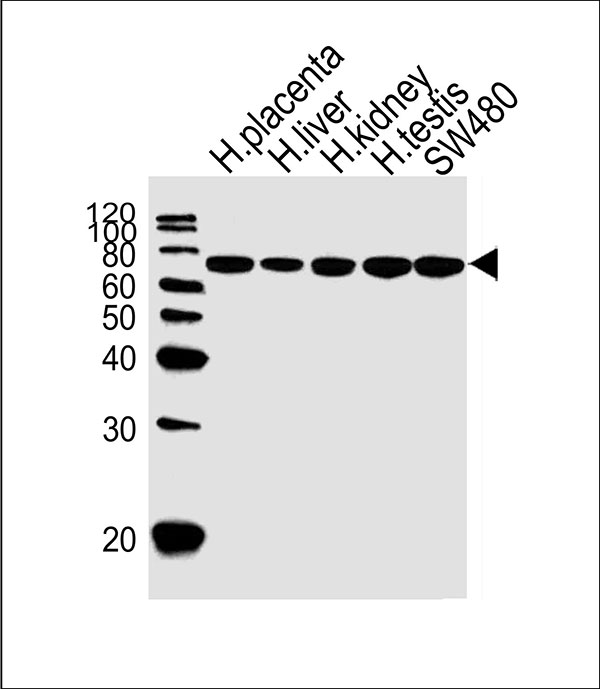TRPV6 Antibody (Center)
Purified Rabbit Polyclonal Antibody (Pab)
- SPECIFICATION
- CITATIONS
- PROTOCOLS
- BACKGROUND

Application
| WB |
|---|---|
| Primary Accession | Q9H1D0 |
| Reactivity | Human |
| Host | Rabbit |
| Clonality | polyclonal |
| Calculated MW | H=83,64 KDa |
| Isotype | Rabbit IgG |
| Antigen Source | HUMAN |
| Gene ID | 55503 |
|---|---|
| Antigen Region | 352-385 aa |
| Other Names | Transient receptor potential cation channel subfamily V member 6, TrpV6, CaT-like, CaT-L, Calcium transport protein 1, CaT1, Epithelial calcium channel 2, ECaC2, TRPV6, ECAC2 |
| Dilution | WB~~1:1000 |
| Target/Specificity | This TRPV6 antibody is generated from a rabbit immunized with a KLH conjugated synthetic peptide between 352-385 amino acids from the Central region of human TRPV6. |
| Format | Purified polyclonal antibody supplied in PBS with 0.09% (W/V) sodium azide. This antibody is purified through a protein A column, followed by peptide affinity purification. |
| Storage | Maintain refrigerated at 2-8°C for up to 2 weeks. For long term storage store at -20°C in small aliquots to prevent freeze-thaw cycles. |
| Precautions | TRPV6 Antibody (Center) is for research use only and not for use in diagnostic or therapeutic procedures. |
| Name | TRPV6 |
|---|---|
| Synonyms | ECAC2 |
| Function | Calcium selective cation channel that mediates Ca(2+) uptake in various tissues, including the intestine (PubMed:11097838, PubMed:11248124, PubMed:11278579, PubMed:15184369, PubMed:23612980, PubMed:29258289). Important for normal Ca(2+) ion homeostasis in the body, including bone and skin (By similarity). The channel is activated by low internal calcium level, probably including intracellular calcium store depletion, and the current exhibits an inward rectification (PubMed:15184369). Inactivation includes both a rapid Ca(2+)-dependent and a slower Ca(2+)-calmodulin-dependent mechanism; the latter may be regulated by phosphorylation. In vitro, is slowly inhibited by Mg(2+) in a voltage-independent manner. Heteromeric assembly with TRPV5 seems to modify channel properties. TRPV5-TRPV6 heteromultimeric concatemers exhibit voltage-dependent gating. |
| Cellular Location | Cell membrane; Multi-pass membrane protein |
| Tissue Location | Expressed at high levels in the gastrointestinal tract, including esophagus, stomach, duodenum, jejunum, ileum and colon, and in pancreas, placenta, prostate and salivary gland Expressed at moderate levels in liver, kidney and testis. Expressed in trophoblasts of placenta villus trees (at protein level) (PubMed:23612980). Expressed in locally advanced prostate cancer, metastatic and androgen-insensitive prostatic lesions but not detected in healthy prostate tissue and benign prostatic hyperplasia |

Thousands of laboratories across the world have published research that depended on the performance of antibodies from Abcepta to advance their research. Check out links to articles that cite our products in major peer-reviewed journals, organized by research category.
info@abcepta.com, and receive a free "I Love Antibodies" mug.
Provided below are standard protocols that you may find useful for product applications.
Background
Calcium selective cation channel probably involved in Ca(2+) uptake in various tissues, including Ca(2+) reabsorption in intestine. The channel is activated by low internal calcium level, probably including intracellular calcium store depletion, and the current exhibits an inward rectification. Inactivation includes both, a rapid Ca(2+)-dependent and a slower Ca(2+)-calmodulin- dependent mechanism, the latter may be regulated by phosphorylation. In vitro, is slowly inhibited by Mg(2+) in a voltage-independent manner. Heteromeric assembly with TRPV5 seems to modify channel properties. TRPV5-TRPV6 heteromultimeric concatemers exhibit voltage-dependent gating (By similarity).
References
Peng J.-B.,et al.Biochem. Biophys. Res. Commun. 278:326-332(2000).
Wood R.J.,et al.BMC Physiol. 1:11-11(2001).
Peng J.-B.,et al.Genomics 76:99-109(2001).
Wissenbach U.,et al.J. Biol. Chem. 276:19461-19468(2001).
Peng J.-B.,et al.Submitted (MAR-2001) to the EMBL/GenBank/DDBJ databases.
If you have used an Abcepta product and would like to share how it has performed, please click on the "Submit Review" button and provide the requested information. Our staff will examine and post your review and contact you if needed.
If you have any additional inquiries please email technical services at tech@abcepta.com.













 Foundational characteristics of cancer include proliferation, angiogenesis, migration, evasion of apoptosis, and cellular immortality. Find key markers for these cellular processes and antibodies to detect them.
Foundational characteristics of cancer include proliferation, angiogenesis, migration, evasion of apoptosis, and cellular immortality. Find key markers for these cellular processes and antibodies to detect them. The SUMOplot™ Analysis Program predicts and scores sumoylation sites in your protein. SUMOylation is a post-translational modification involved in various cellular processes, such as nuclear-cytosolic transport, transcriptional regulation, apoptosis, protein stability, response to stress, and progression through the cell cycle.
The SUMOplot™ Analysis Program predicts and scores sumoylation sites in your protein. SUMOylation is a post-translational modification involved in various cellular processes, such as nuclear-cytosolic transport, transcriptional regulation, apoptosis, protein stability, response to stress, and progression through the cell cycle. The Autophagy Receptor Motif Plotter predicts and scores autophagy receptor binding sites in your protein. Identifying proteins connected to this pathway is critical to understanding the role of autophagy in physiological as well as pathological processes such as development, differentiation, neurodegenerative diseases, stress, infection, and cancer.
The Autophagy Receptor Motif Plotter predicts and scores autophagy receptor binding sites in your protein. Identifying proteins connected to this pathway is critical to understanding the role of autophagy in physiological as well as pathological processes such as development, differentiation, neurodegenerative diseases, stress, infection, and cancer.


